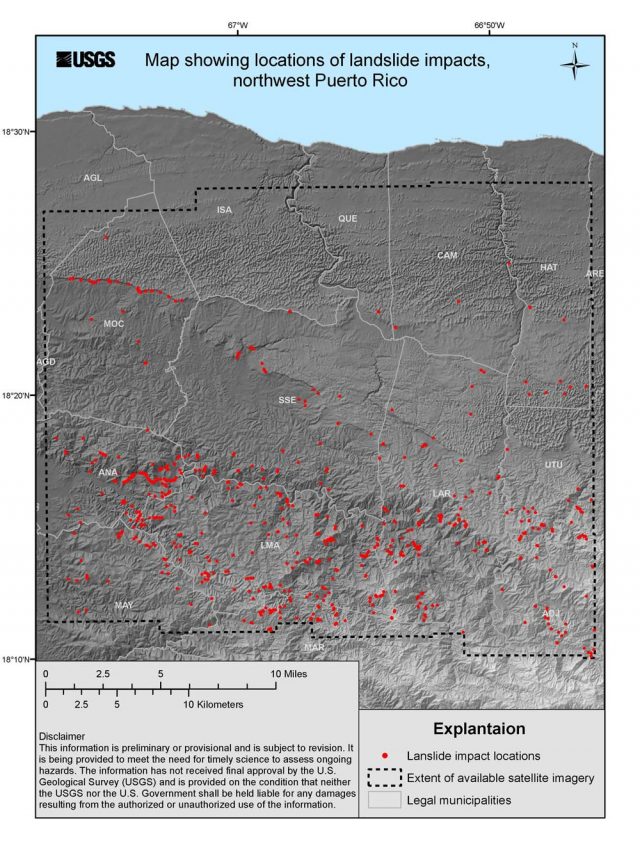5 October 2017
Hurricane Maria: USGS landslide impact maps from Puerto Rico reveal the extent of the devastation
Posted by Dave Petley
Hurricane Maria: USGS landslide impact maps from Puerto Rico reveal the extent of the devastation
From across the Atlantic, the response of the White House to the Hurricane Maria disaster in Puerto Rico looks astonishing. With little fanfare, the USGS has now started to release maps of the impacts of landslides triggered by the hurricane, created through the analysis of satellite imagery. USGS staff are past masters at this sort of mapping, which is both challenging and time-consuming. They have released the first tranche of data, for a part of northwest Puerto Rico:-

USGS map of the impacts of landslides triggered by Hurricane Maria for a part of Puerto Rico.
.
It is important to note that this not a landslide map, it is a map of the impacts of landslides – i.e. the locations in which a landslide has affected a road, a building or another element of infrastructure. This is illustrated by one of the images that the USGS has released alongside the map:-

Digital Globe image of the imoacts of landslides triggered by Hurricane Maria in Puerto Rico. The red dots are the mapped impacts on humans,
.
There are eight mapped impacts (the red dots) on this image, but far more landslides. Another example of the extent and impact of this event is this image, from the San Antonio Express-News, that shows multiple landslides and extremely high levels of damage in the upland areas of Puerto Rico:-

Image from the San Antonio Express-News showing landslide damage from Hurricane Maria in Puerto Rico
.
The Washington Post has published a rainfall map for Hurricane Maria in Puerto Rico:-

Map of the rainfall deposited on Puerto Rico for Hurricane Maria. Map by the Washington Post
.
This suggests that the mapped area had some of the higher levels of rainfall, but this amount is replicated across much of the rest of the island. In turn, this suggests that similar levels of landslide damage are likely elsewhere.


 Dave Petley is the Vice-Chancellor of the University of Hull in the United Kingdom. His blog provides commentary and analysis of landslide events occurring worldwide, including the landslides themselves, latest research, and conferences and meetings.
Dave Petley is the Vice-Chancellor of the University of Hull in the United Kingdom. His blog provides commentary and analysis of landslide events occurring worldwide, including the landslides themselves, latest research, and conferences and meetings.
The rests of Maria (and Lee) were transported further North (https://www.nasa.gov/feature/goddard/2017/maria-atlantic-ocean) across the Atlantic to UK and Norway. In Norway the intense rain associated to this system triggered a huge flood event and many shallow landslides in Southern Norway between 1st and 2nd october. Both flood and landslide events were forecasted in advance http://www.varsom.no/en/flood-and-landslide-warning-service/?date=2017-10-01 but damages to infrastructure and buildings could not be avoided. We should investigate better and more globally the real extension and effects of these tropical cyclones.